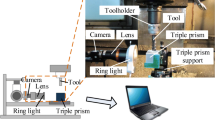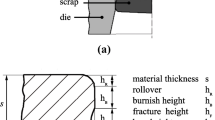Abstract
Microdrills are fundamental cutting tools used in mechanical microdrilling. The web thickness of a microdrill is an important design parameter in balancing drill rigidity and chip removal ability. Conventional destructive method for measuring the web thickness is currently adopted by some microdrill manufactures. The conventional method must be carried out manually by experienced inspectors and thus lacks sufficient efficiency and accuracy. To improve the drawbacks of the conventional method, a vision-aided automation system for performing the destructive web thickness measurement is introduced in this paper. Based on the integration of motion and logic control, machine vision, and image processing techniques, an automated measuring process is then established. Experiments to measure the web thickness of microdrill samples were conducted to test the feasibility and effectiveness of the presented automation system and automated measuring process. The experimental results showed that the presented vision-aided automation system, in combination with the automated measuring process, could be an efficient and precise manner for replacing the conventional manual procedure in performing the destructive web thickness measurement of certain microdrills.
Similar content being viewed by others
References
Coombs CF Jr (ed) (2008) Printed circuits handbook. McGraw-Hill, New York
Dahotre NB, Harimkar SP (2008) Laser fabrication and machining of materials. Springer, New York, pp 247–288
Ganguly D, Acherjee B, Kuar AS, Mitra S (2012) Hole characteristics optimization in Nd:YAG laser micro-drilling of zirconium oxide by grey relation analysis. Int J Adv Manuf Technol 61(9–12):1255–1262
DeGarmo EP, Black JT, Kohser RA (2003) Materials and processes in manufacturing, 9 (update edition)th edn. Wiley, Hoboken, New Jersey, pp 214–216, pp. 583–597, pp. 712–714
Groover MP (2011) Principles of modern manufacturing, 4th edn. Wiley, Hoboken, New Jersey, pp 561–564, pp. 631–632, pp. 984–985
Stephonson DA, Agapiou JS (1997) Metal cutting theory and practice. Marcel Dekker, New York, pp 205–236
Imran M, Mativenga PT, Gholinia A, Withers PJ (2011) Evaluation of surface integrity in micro drilling process for nickel-based superalloy. Int J Adv Manuf Technol 55(5–8):465–476
Imran M, Mativenga PT, Withers PJ (2012) Assessment of machining performance using the wear map approach in micro-drilling. Int J Adv Manuf Technol 59(1–4):119–126
Tien FC, Yeh CH, Hsieh KH (2004) Automated visual inspection for microdrills in printed circuit board production. Int J Prod Res 42(12):2477–2495
Tien FC, Yeh CH (2005) Using eigenvalues of covariance matrices for automated visual inspection of microdrills. Int J Adv Manuf Technol 26(7–8):741–749
Su JC, Huang CK, Tarng YS (2006) An automated flank wear measurement of microdrills using machine vision. J Mater Process Technol 180(1–3):328–335
Huang CK, Liao CW, Huang AP, Tarng YS (2008) An automatic optical inspection of drill point defects for micro-drilling. Int J Adv Manuf Technol 37(11–12):1133–1145
Duan G, Chen YW, Sukegawa T (2010) Automatic optical flank wear measurement of microdrills using level set for cutting plane segmentation. Mach Vis Appl 21(5):667–676
Perng DB, Hung CY, Chen YC (2005) An AOI system for microdrill measurement. In: Proc 18th Int Conf Prod Res, Salerno, Italy
Huang CK, Wang LG, Tang HC, Tarng YS (2006) Automatic laser inspection of outer diameter, run-out and taper of micro-drills. J Mater Process Technol 171(2):306–313
Tokyo Opto-Electronics Corp (2011) Laser micro-gauge (LMG). http://www.toe.co.jp/lmghome_e.htm
Chuang SF, Chen YC, Chang WT, Lin CC, Tarng YS (2010) Nondestructive web thickness measurement of micro-drills with an integrated laser inspection system. Nondestruct Test Eval 25(3):249–266
Keyence Corp (2013) Laser confocal displacement meter (LCDM). http://www.keyence.com/dwn/downloadlt_ka.pdf
Chang WT, Lu SY, Chuang SF, Shiou FJ, Tang GR (2013) An optical-based method and system for the web thickness measurement of microdrills considering runout compensation. Int J Precis Eng Manuf 14(5):725–734
Keyence Corp (2013) Optical micrometer. http://www.keyence.com/dwn/downloadls_7000_ka.pdf
Keyence Corp (2013) Surface scanning LCDM. http://www.keyence.com/dwn/lt_9000.pdf
Tachikawa International Corp (2013) Drill sharpener. http://www.tachikawa.com.tw/eng/product.htm
Mitutoyo Corp (2013) Measuring microscopes. http://www.mitutoyo.co.jp/eng/support/service/catalog/04/E14003.pdf
National Instrument Corp (2007) NI vision concepts manual. National Instrument Corp, Austin, Texas, pp 3.1–3.18, pp. 5.12–5.35, pp. 8.1–8.9, pp. 11.1–11.22
Jain R, Kasturi R, Schunck BG (1995) Machine vision. McGraw-Hill, New York, pp 76–86, pp. 140–185, pp. 309–405
Gonzalez RC, Woods RE (2002) Digital image processing, 2nd edn. Prentice-Hall, Upper Saddle River, New Jersey, pp 134–137, pp. 519–536, pp. 568–585
Chen TH, Chang WT, Shen PH, Tarng YS (2010) Examining the profile accuracy of grinding wheels used for microdrill fluting by an image-based contour matching method. Proc Inst Mech Eng Part B J Eng Manuf 224(6):899–911
Chang WT, Chen TH, Tarng YS (2011) Measuring characteristic parameters of form grinding wheels used for microdrill fluting by computer vision. Trans Can Soc Mech Eng 35(3):383–401
Chang WT, Su CH, Guo DX, Tang GR, Shiou FJ (2013) Automated optical inspection for the runout tolerance of circular saw blades. Int J Adv Manuf Technol 66(1–4):565–582
Faires JD, Burden R (2003) Numerical methods, 3rd edn. Thomson Learning, Pacific Grove, California, pp 64–110, pp. 340–356, pp. 416–428
Yamaguchi F (1988) Curves and surfaces in computer aided geometric design. Springer, Berlin
Zeid I (1991) CAD/CAM theory and practice. McGraw-Hill, New York
Litvin FL (1989) Theory of gearing. NASA Reference Publication 1212, Washington, DC, pp 87–92, pp 241-295
Litvin FL (1994) Gear geometry and applied theory. Prentice-Hall, Englewood Cliffs, pp 258–287
Chang WT, Wu LI (2009) Computerized tolerance analysis of disk cam mechanisms with a roller follower. Eng Comput 25(3):247–260
Chang WT, Wu LI (2009) A computerized approach for tolerance analysis of disk cam mechanisms with a flat-faced follower. Trans Can Soc Mech Eng 33(3):459–486
Beckwith TG, Marangoni RD, Lienhard JH (2004) Mechanical measurements—5th edn. Pearson Education Taiwan Ltd, Taipei, Taiwan, pp 45–125
Arora JS (2004) Introduction to optimum design, 2nd edn. Elsevier, Oxford, pp 650–654
Author information
Authors and Affiliations
Corresponding author
Appendix
Appendix
The method used to determine common tangent circles of two regular planar curves is described below. Considering two planar curves Λ P and Λ Q represented in a Cartesian coordinate system OF–XFYF, as shown in Fig. 16, their parametric vector equations can be referred to Eqs. (20) and (21), respectively. When a point P Λ on curve Λ P is determined by Eq. (20) with a given value of variable w 1, there must be a circle C Λ commonly tangent to curves Λ P and Λ Q , while point P Λ and another point Q Λ on curve Λ Q are the common tangent points. Assuming curves Λ P and Λ Q and circle C Λ are boundary contours of three rigid bodies, through the concept of simulated higher-pair contact analysis [33–36], circle C Λ can be determined numerically. By denoting O Λ and r Λ as the center and radius of circle C Λ , respectively, the necessary condition for the contact between curve Λ P and circle C Λ is that point P Λ on curve Λ P and a point C P on circle C Λ must be coincide, that is,
where O Λx and O Λy are the XF- and YF-directional components of point O Λ , and θ P is the angle of vector O Λ C P measured from the +XF-direction counterclockwise. The sufficient condition for the contact between curve Λ P and circle C Λ is that the normal vector to point P Λ , denoted by N P , must be collinear with vector O Λ C P , in other words, the cross-product of vectors N P and O Λ C P must be zero:
where P ′ Λx (w 1) = dP Λx (w 1)/dw 1 and P ′ Λy (w 1) = dP Λy (w 1)/dw 1 are the XF- and YF-components of the tangent vector to point P Λ , and k is the unit vector of the ZF-axis. Likewise, the necessary condition for the contact between curve Λ Q and circle C Λ is that point Q Λ on curve Λ Q and a point C Q on circle C Λ must be coincide, that is,
where θ Q is the angle of vector O Λ C Q measured from the +XF-direction counterclockwise. The sufficient condition for the contact between curve Λ Q and circle C Λ is that the normal vector to point Q Λ , denoted by N Q , must be collinear with vector O Λ C Q , in other words, the cross-product of vectors N Q and O Λ C Q must be zero:
where Q ′ Λx (w 2) = dQ Λx (w 2)/dw 2 and Q ′ Λy (w 2) = dQ Λy (w 2)/dw 2 are the XF- and YF-components of the tangent vector to point Q Λ . Therefore, from Eqs. (25) to (28), a nonlinear system of equations can be obtained as:
When the value of w 1 is given, the nonlinear system of equations has six unknowns w 2, O Λx , O Λy , r Λ , θ P , and θ Q that must be solved simultaneously. By applying the well-known Newton–Raphson method [30, 38], the six unknowns can be solved numerically. For a given range of w 1, a group of common tangent circles {C Λ } and their radii {r Λ } can be determined. When curves Λ P and Λ Q represent the concave flute contours of a cross-sectional plane of a microdrill, a minimum common tangent circle Č Λ among all determined common tangent circles {C Λ } exists such that its radius ř Λ is the minimum radius among radii {r Λ }, that is,
Hence, the cross-sectional web thickness w (MC) is accordingly obtained by:
in which, the value of w (MC) is the diameter of the minimum common tangent circle Č Λ .
Rights and permissions
About this article
Cite this article
Chang, WT., Chuang, SF., Tsai, YS. et al. A vision-aided automation system for destructive web thickness measurement of microdrills. Int J Adv Manuf Technol 71, 983–1003 (2014). https://doi.org/10.1007/s00170-013-5509-5
Received:
Accepted:
Published:
Issue Date:
DOI: https://doi.org/10.1007/s00170-013-5509-5





